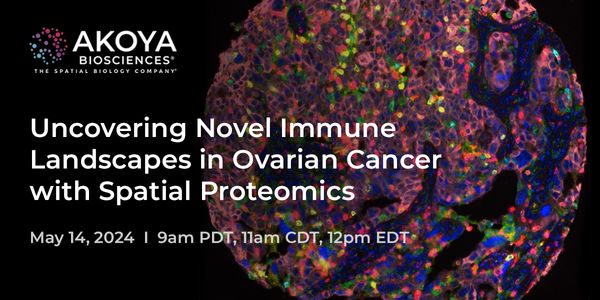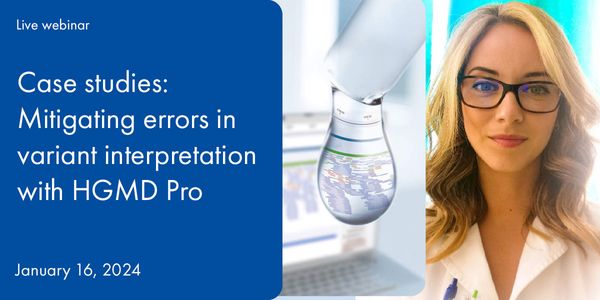Ovarian Cancer
Ovarian Cancer: is a cancer that ignites in the female organs that produce eggs (ovaries). Ovarian cancer frequently goes undetected until it has spread within the pelvis and belly. At this late stage, ovarian cancer is more severe to treat and can be fatal.
-
DEC 10, 2025 | 8:00 AMMass spectrometry (MS)-based proteomic biomarker discovery pipeline commonly begins with large-scale profiling techniques detecting thousands of candidate biomarkers. Efficiently triaging th...MAR 07, 2025 | 1:00 PMC.E. CREDITSOvarian cancer remains a significant challenge in women's health, with high mortality rates due to late-stage diagnosis. This webinar aims to provide healthcare professionals with an in-...DEC 11, 2024 | 8:00 AMPrecision Diagnosis of Ovarian Cancer – Identification of Protein Biomarkers that Separate Benign from Malignant Tumors Ovarian cancer has the highest mortality among gynecological can...Homologous recombination repair deficiency (HRD) is associated with response to poly-ADP-ribose polymerase inhibition (PARPi) therapy in advanced ovarian cancer. In combination with CGP, the...Speaker: Carlo Bifulco, MD , Brian Piening, PhDPresented at: The Power of Comprehensive Genomic Profiling Testing
The Genomes2People Research Program (G2P), led by Robert Green at Brigham and Women’s Hospital, the Broad Institute, Ariadne Labs, and Harvard Medical School, conducts research to acce...
Speaker:
Robert C. Green, MD, MPH
MAY 14, 2024 | 9:00 AM
C.E. CREDITS
Survival rates for patients with high grade serous carcinoma of the ovary (HGSC) have stagnated for the past fifty years. Despite the presence of tumor mutations and infiltration of immune c...
MAY 14, 2024 | 8:00 AM
Latest advancements in limited sample analysis will be presented. The webinar will focus specifically on single-cell proteomics and deep visual proteomics and how latest innovations in mass...
Speaker:
Karl Mechtler
, Manuel Matzinger
, Sophia Steigerwald
Sponsored By: Thermo Fisher Scientific
APR 18, 2024 | 6:00 AM
Ovarian Cancer is the 8th most common cancer in the world, and Europe has the highest rates of ovarian cancer in the world. Although the cancer antigen 125 (CA 125) assay has been used for m...
Across many cancers, mortality is associated with metastasis and acquired drug resistance, both of which often manifest in recurrent disease. Central to these phenomena is epithelial to mese...
JAN 16, 2024 | 8:00 AM
The clinical interpretation of genetic testing results remains one of the most significant hurdles in effectively applying genomics in modern medicine. Errors in variant interpretation, whet...
OCT 10, 2023 | 10:00 AM
For patients with advanced non-small cell lung cancer (NSCLC), tissue samples are typically small biopsies. These samples undergo standard of care evaluation for >10 biomarkers to identif...
OCT 10, 2023 | 9:00 AM
Numerous studies have shown that homologous recombination deficiency (HRD) is a genome-wide biomarker present in high grade ovarian and breast cancers. A cancer therapeutic class, PARP inhib...
OCT 10, 2023 | 1:00 AM
Numerous studies have shown that homologous recombination deficiency (HRD) is a genome-wide biomarker present in high grade ovarian and breast cancers. A cancer therapeutic class, PARP inhib...
SEP 20, 2022 | 9:00 AM
Date: September 20, 2022 Time: 9:00am (PDT), 12:00pm (EDT), 6:00pm (CEST) Variation in gene expression among cell types, tissues, and organisms is commonly examined by reverse transcription...
MAY 24, 2022 | 11:00 AM
Date: May 24, 2022 Time: 11:00am (PDT), 2:00pm (EDT), 7:00pm (CEST) NGS tumor profiling has become the mainstay of modern cancer therapy. Several NCCN-guided and FDA-approved therapies are c...
Speaker:
Dr. Christopher Lum, M.D.
, Zan Halford, M.S. SMB(ASCP)CM,
Sponsored By: BioDiscovery, A Bionano Genomics Company
MAR 31, 2022 | 11:00 AM
Date: March 31, 2022 Time: 11:00am (PDT), 2:00pm (EDT), 8:00pm (CET) Formalin-fixed paraffin-embedded (FFPE) tissues are the most widely used clinical sample types in histology and molecular...
JUN 08, 2021 | 10:00 AM
Date: June 8, 2021 Time: 10:00am (PDT), 1:00pm (EDT) Most deaths from ovarian and endometrial cancer are due to high-grade subtypes that metastasize before they are detectable by available...
...
High grade serous ovarian cancer is characterized by genomic instability, with ~50% of advanced tumors harboring homologous recombination repair (HRR) pathway deficiency (HRD). HRD results i...
Speaker:
Natalie Ngoi, MBBS, MMed, MRCP
Presented at: OncomineWorld 2022: A Virtual NGS Education Meeting
High grade serous ovarian cancer is characterized by genomic instability, with ~50% of advanced tumors harboring homologous recombination repair (HRR) pathway deficiency (HRD). HRD results i...
Speaker:
Natalie Ngoi, MBBS, MMed, MRCP
Presented at: OncomineWorld Autumn: A virtual NGS education meeting
Background: Healthcare access (HCA) encompasses five important dimensions: Affordability, Availability, Accessibility, Accommodation and Acceptability. Published studies of cancer typically...
Speaker:
Tomi Akinyemiju, PhD, MS
Combinatorial inhibition of effector and feedback pathways is a promising treatment strategy for KRAS mutant cancers. However, the particular pathways that should be targeted to optimize the...























